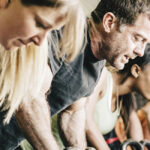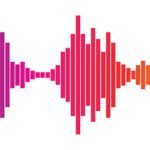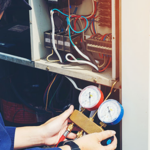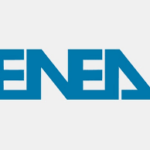ADVICES TO FIND THE NORTHERN LIGHTS
What are the “Northern Lights”?
Very quickly I make a brief introduction about it, leaving the ability to explain these stuffs to people and sites more competent than me. The sun, in all its power and beauty, emits the so-called “solar wind”, a shower of electrons that invests the earth , they are attracted by the earth’s magnetic field which has the shape similar to an apple (the field is concentrated at the poles and away from them it moves away from the earth out of the atmosphere). When these electrons meet the chemical elements in the atmosphere (nitrogen, oxygen…) they release energy, this energy is released through the colours. Thus combining the passage of the magnetic field in the atmosphere at the poles and the release of energy through colors due to the encounter between solar wind and gas in the atmosphere, here is the magnificent spectacle of the northern lights.

Solar wind image (source: meteoweb.eu)
Where can I see these?
As known and explained in the previous point, the possibility of seeing the northern lights increases near the poles. I will refer only to the northern hemisphere, because it is the area where I went and I have experience to share. Following what described above, the “enter” of the magnetic field occurs starting from the Arctic Circle, so starting from a latitude >66° approximately. Within this latitude there are many states (Sweden, Norway, Finland, Iceland, Russia, USA (Alaska), Canada and Denmark (Greenland)) and many cities. An element that many people ignore is the role of the Gulf Stream on the Scandinavian peninsula (specifically Norway), in fact it allows to maintain warmer temperatures than other places at the same latitude. This combination of “warm” temperature and high latitude allow the best percentage to see the Northern Lights. Talkin about the cities, the most organized and indicated is called the “Arctic capital”: Tromsø. It is the largest city of the Arctic Circler in Europe, it bases a lot of its income on tourism and is enlarging its infrastructure and hospitality (the new airport terminal should be finished in 2024). Consequently, if you go to that place you can be sure that you have all the credentials to be able to see it.
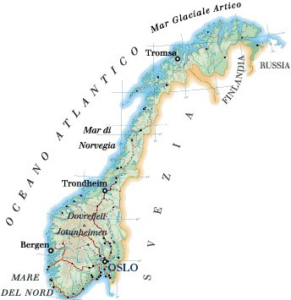
Like Tromsø, there are other cities and towns where you can see it (Narvik, Bodo or even in Sweden: Abisko, Kiruna), the question is: what you want to do? The bigger and more touristy a city is, the more alternatives there are. If the week you are there you do not see the Northern Lights, the risk of getting bored could be high in countries with little supply.
Considering the way I experience those environments, I’m happy to be surrounded by nature in silence even without the “northern lights”.
Chance to see it?
There are many elements that contribute to the possibility of seeing the northern lights, some of them predictable, others bonded to how much we are lucky.
• SOLAR ACTIVITY: Theoretically in 2024 there should be the greatest solar activity since 2013, when I went in 2019 they told me that the activity has a cyclicity of 8 years (every 4 there is the minimum and every 4 the maximum), in 2019 there was a minimum and I saw something, in 2023 there was a maximum and I saw nothing. Let’s say that there is not much clarity on these aspects, it is not known whether deliberately or not (see disinformation below);
• LIGHT: Stupid to say, but if you want to see the lights in the sky you have to do it at night, so the arctic night is the best time. You have to go outside the urban area where there is light pollution;
• MOON: Going with the full moon is strongly not recommended, it creates a strong luminosity which reduces the possibility of seeing lights coming from the space; If you can choose, it’s best to go with the moon as inconspicuous as possible.
• CLOUDS: If the sky is overcast you can forget to see the northern lights, at least with the naked eye.
In summary, the long-term predictable elements to take into account are: MOON and NIGHT. In the short term: CLOUDS. Theoretically long-term but uncertain: SOLAR ACTIVITY.
How to put yourself in the best condition to see it?
Too touristy areas (prologue)
The negative aspect, consider it as a personal opinion, is that when the event becomes too easy to reach it is emptied of its essence and magnificence. It becomes a disposable aspect that is deprived of the respect due to it. A bit like the monuments in Italy: “I come, I take the most beautiful photo possible to share on social networks (preferably doing something whimsical by ruining the monument) and I leave”, saying that I have seen it. If I look at something through a screen I’m only seeing it and I’m not observing anything. Nothin reamin inside us after a view like this, just remain the same that other can see from their couch. In fact it has become just a disposable element, I take the bus, which takes me to the place, I take the picture taken by a professional photographer, I go back to the heat by bus and to the hotel. No one requires you to stay at -15°C and freeze your hands waiting for the northern lights, but making it so “easy” in my opinion makes it lose its value.
Logistic informations
Another contraindication is when something becomes touristic, the goal are the money and through the years became the only purpose. I want to make present a repid resume of the means of transport and an evaluation of these thorugh different aspects (MOBILITY, PRICE, INDEPENDENCE and EXPERTISE) (evaluation scale from very bad 0 to excellent 3):
• Private car rental (PLUS: I go wherever I want, cost between 65-75€ per day, MINUS: where am I going? (reference below misinformation) M:3, P:2, I:3 and C:0); 
• I’m going on an organized trip with a minibus (up to 20 seats) (PLUS: combination of expert guide and not too bulky vehicle, MINUS: price no less than €130 per trip. M:2, P:0, I :0 and C:3);
• I’m going on an organized trip by bus (up to 50 seats) (PLUS: not too expensive (in any case not less than €95), MINUS: little mobility and vulgar tourism. M:0, P:1, I:0 and C:3).
Explenation of the ratings
I will now go more in deep in which aspects have allowed us to give the evaluations as above:
MOBILITY: the possibility of moving freely with a car in an area like this really allows you to have a lot of possibilities open. You don’t have not be “dependent” on external factors or perhaps having to do unwanted things in order to achieve what you want. I can stop where I want and how much I want (cold permitting). Obviously, driving in an area with icy roads, with little lighting in remote areas and the risk of damaging the car against moose is to be taken into consideration. Going with a not too big minibus could be a good compromise between mobility and competence. The aspect of being tied to someone else allows you to have expertise, to be taken to places where you can see the aurora with the greatest possibility. However, at the same time, if you consider the time, how long you can stay, and the place chosen, they are bound to the tour guide. Going by bus like the scheduled ones means being at the bottom of the food pyramid of the tourist stereotype. They have little flexibility, so they can only stop at large pitches not so common along the coasts of the fjords. Furthermore, if you depend on the photographer to take the photos, the aurora does not have huge duration, and for each photo you need exposure of even 10-15 seconds, while you are in line you may see the possibility of a nice picture vanished.
PRICE: the costs, compared to a few years ago (January 2019) have increased significantly. A trip with a 15/20-seat minibus cost €75 per person (although not a few). Furthermore, if the odds were low, the event was postponed to the following day without adding costs or losing the money. The guide “chased” the northern lights, sharing this battle with us and using a very precise app on where to see it (also shared with us) and communicating with the other groups, who were out looking, in order to have instant knowledge of the best locations. Instead, what I have seen recently (January 2023), was the need to make money and little else. For a seat on a bus with 40 other people €99 each, we go to some places and hope to see it, if we don’t see it, sorry it will be for next time, with no element of reimbursement. Obviously you cannot command nature to make the northern lights appear or not (thankfully), but we have gone from one opposite to another. For a trip with a 15-seater minibus the costs are much higher (from €150 per head up) and I don’t think there can be the same passion that was shown in previous years.
INDEPENDENCE: if you choose to rely on local guides with their own means of transport, you are subject to their times and their choices. Usually, the visit lasts from 5 to 7 hours with departure at 18 and return around midnight, the positions with the big bus are few and reachable by anyone, with the minibus it becomes a little more flexible. With your own car is up to you.

COMPETENCE: relying on expert guides allows the guarantee of going to safe places, to be sure on behaving in the right way in an unfamiliar environment and to be in the best possible place to be able to see the northern lights. However, one aspect that I have noticed and of which I strongly suspect, personal opinion, is that there is a desire not to correctly inform (misinformation) the tourist of where to see the “northern lights” and with what possibilities. There are so many sites all with conflicting opinions, you don’t know which ones to trust and regardless you are invited to “TRY” the search. In this way, in the high season, coverage of all seats is guaranteed every evening, whether the show can be seen or not. I consider this an attitude deeply rooted in tourism that I thought far away from these areas of the world.
What to do beside the “Northern lights”:
If you are unable to see the northern lights, or you want to have other adventures, or, better yet, combine the northern lights by having other experiences. Below I list the things I have personally experienced:
◦ CABLE CAR:
The city of Tromsø is divided in three areas, the central island where there is the city itself, connected with two bridges with other parts: on one side there is the airport and the other where there is the residential area and a nice relief to be able to appreciate the view of the fjord. Referring to the latter part, there is a cable car that takes you to the top of the relief above the city (Fjellheisen). From this point you really have a splendid view over the whole area of Tromsø and, in case of Aurora Borealis, it could be one of the most beautiful places to appreciate it. Being able to combine urban part and natural part. In fact, the light pollution of the city weighs relatively being about 400m above it. Beware of the wind and the cold: I don’t think you go to those latitudes badly dressed, but if in the city you can also find temperatures around 0°C and with little wind. There, you could easily find lower temperatures and a strong wind. At the top of the cable car there is, however, an enclosed area and a bar/restaurant. In addition, there is a nice vantage point from which to appreciate the city.
If you exit at the back of the cable car arrival you can climb the relief to go in the dark and increase the possibility of seeing the northern lights even if less bright.
COST: it is not at all cheap as transport. The price is 35€ per person round trip, however having free times for the return.

Picture made from the arriving of the cable car (source: tourscanner.com)
◦ SLEDGE DOGS:
Experience certainly very touristy but really beauty. If you love dogs and are passionate about the film “Balto”, in a small way, this reality can lead you to relive beautiful emotions. Usually the farms where they lead are about 1h30’/2h outside the city. Different time intervals are proposed to be able to take the trips:
◦ Morning (9.00 – 15.00)
◦ Afternoon (11.00 – 17.00)
◦ Evening (16.00-22.00)
The evening one is certainly recommended, if you could combine the tour with the dogs even with the northern lights, it would be splendid (the adventure is not focused on the search for the aurora but if it is found it is not disdained). However, even walking around carried by dogs in a territory that appears unexplored with the flashlight on the head is also beautiful.
Usually, the tour is built for two people, who take turns leading the dogs in a total of about 1h/1h15′. Initially you are given directions to drive the sled, warm clothes and gloves and, finally, you assign the group of dogs that will take you around. There are always 6 dogs in pairs of two for each sled. There will be an open-the-line guide and a close-the-line guide to accompany you. 
Driving the sled is fun but remember to brake because otherwise they will keep pulling. At the end of the trip you can stop and cuddle the various dogs, each farm will have no less than 100 dogs in order to give everyone the right rest, and you will be offered a hot snack.
COST: this event is really very expensive, it is not less than €200 each, for those I have done it is perhaps the most beautiful but the cost is certainly not negligible.
◦SEARCH FOR WHALES AND ORCAS
Event always very touristic but which releases unique emotions. Don’t expect to see the stunts you see on TV or in movies, I wish you so but it’s very rare. It could also happen that you don’t see anything, a bit like the “northern lights”. The middle way, which I think is the most common, is to see them more or less close as they immerse and emerge. With big ships you don’t have great mobility in being able to follow every curve they make but if you are lucky enough you can see them even a few meters away, just hearing their breathing is a breath-taking emotion. You can feel the power of their lungs and the depth of their breath, which gave me this sense of majesty. This trip is always done starting around 9 am and then returning around 2.30/3.00 pm, in this way it will be possible to exploit the part of the polar night with light (in fact there are moments of the day when there is a sort of of dawn (from about 9.30 to 13.30 in January), even if you don’t see the sun, which makes everything clearly visible). In this case, having a car could come in really handy, being able to reach points closer to the cetacean sighting areas and going on a trip with a small boat allows you to be really close to them with excellent maneuverability.
COST: Here too the cost is not the cheapest, considering the trip made with a boat with no less than 150 people on board (a bit like the bus we described above), it costs €140 each.
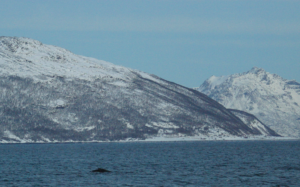
◦ DINNER CRUISE IN THE FJORD
One trip that I really enjoyed and where I was very happy, which isn’t publicized much (maybe they’ve just started doing it) is the night tour with dinner in the fjord. On board a boat with a crew of 5 and about twenty places to eat, all the seats are positioned to have a view towards the outside and, unexpectedly, the dinner was really excellent (for an italian to say “excellent” about food in abroad countries is really strange). If you are lucky you will also be able to see the northern lights during dinner. Then they still manage to brighten the journey with local tales and stories. Let’s say that the “Northern light” are not the priority of the trip.
COST: €160 per person
◦MARATHON/HALF MARATHON
For those who want to do something completely “outside the box”, they also organize a truly unique event in this location. More or less 3000 participants from different parts of the world. It’s called the Polar Night Half Marathon (reference with costs: https://www.msm.no/en/arrangement/polarnighthalfmarathon/). Apart from the name, the distances are different (5, 10, 21 and 42 km) and the climate is really surreal.

I did the 10km run and I have to admit it’s really something special, a very nice climate, with people cheering outside the houses, and running on snow/ice (they put gravel anyway and you need at least some trail shoes). The temperature could be quite tough (I did it at -10°C and the first 2km weren’t very easy), but if well covered it can be overcome. I feel like recommending it mostly for the reality in which it takes place, running along the fjords during the polar night, well, not much to add!
COSTS:
In order to make a resume of what listed above and give you some ideas of the cost, here we are:
• Hotel room for 2 people without breakfast: 130€/night
• Flight from Milan, round trip : 330€
• Flight from London, round trip: 380€
• Go outside to eat an hamburger: 20€/person
• Breakfast, with coffee and not really good “brioche”: 10€/person
• Restaurant a bit above the average: 40€/person (ask for tap water, for a bottle of the mineral one they ask even 5€)
• Public transports: 90 minutes ticket: 3,50€
• Taxi from the airport to the city (night transport): 20€
• 5 days holiday with included the foods but excluded the different adventures listed above: not less than 1000€/person. If you want to have some different experiences and rent a car, not less than 1500€/person.

WHERE TO ENQUIRE:
For the accommodation sites, unfortunately, I just tell you to look at the usual ones.
On the other and to book excursions and visits I recommend: https://www.visittromso.no/ . It is the official tourist office of the city, to refer to for excursions, in case of problems they guarantee a refund and are very efficient in answering and helping in case of doubts. All the possible activities are marked on their website and I advise you to book everything through them.

